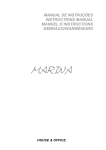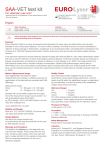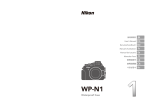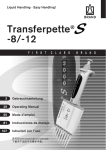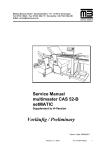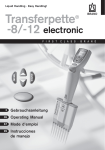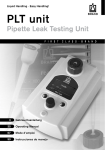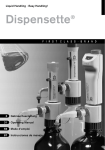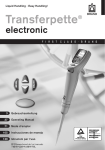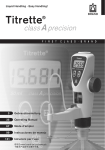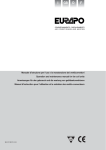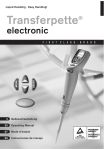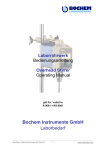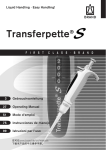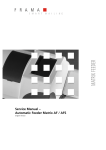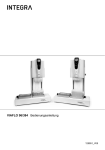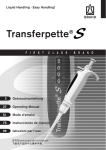Download Transferpette®-8/-12 - BrandTech Scientific
Transcript
Transferpette®-8/-12 Gebrauchsanleitung Bitte vor Gebrauch sorgfältig lesen und alle Bedienungs- und Sicherheitshinweise befolgen! Operating Manual Please read carefully before use, and follow all operating and safety instructions! ® BrandTech Scientific, Inc. · 11 Bokum Road · Essex, CT 06426-1506 · USA Phone: (860) 767-2562 · Fax: (860) 767-2563 · Internet: www.brandtech.com Inhalt Sicherheitsbestimmungen Verwendungszweck Einsatzbeschränkungen Bedienelemente Handhabung Pipettieren Wartung Justieren Volumen kontrollieren Einzelteile Reinigung Reparaturen Autoklavieren Störung – was tun? Technische Daten Bestelldaten Zubehör und Ersatzteile Zur Reparatur einsenden Entsorgung Mängelhaftung Contents Seite 4 6 7 8 8 10 13 14 15 18 19 22 30 31 33 34 34 38 38 39 Safety Instructions Purpose Operating Limitations Operating Elements Handling Pipetting Maintenance Adjustment Checking the volume Components Cleaning Repairs Autoclaving Trouble Shooting Specifications Ordering Data Spare Parts and Accessories Return for Repair Disposal Warranty -3- Page 4 6 7 8 8 10 13 14 15 18 19 22 30 32 33 34 34 38 38 39 -4- Sicherheitsbestimmungen Safety Instructions Bitte unbedingt sorgfältig durchlesen! Please read the following carefully! Dieses Gerät kann in Kombination mit gefährlichen Materialien, Arbeitsvorgängen und Apparaturen verwendet werden. Die Gebrauchsanleitung kann jedoch nicht alle Sicherheitsprobleme aufzeigen, die hierbei eventuell auftreten. Es liegt in der Verantwortung des Anwenders, die Einhaltung der Sicherheits- und Gesundheitsvorschriften sicherzustellen und die entsprechenden Einschränkungen vor Gebrauch festzulegen. This instrument may sometimes be used with hazardous materials, operations, and equipment. It is beyond the scope of this manual to address all of the potential safety risks associated with its use in such applications. It is the responsibility of the user of this pipette to consult and establish appropriate safety and health practices and determine the applicability of regulatory limitations prior to use. 1. Jeder Anwender muss diese Gebrauchsanleitung vor Gebrauch des Gerätes gelesen haben und beachten. 2. Allgemeine Gefahrenhinweise und Sicherheitsvorschriften befolgen, z.B. Schutzkleidung, Augenschutz und Schutzhandschuhe tragen. Beim Arbeiten mit infektiösen oder gefährlichen Proben müssen die Standardlaborvorschriften und -vorkehrungen eingehalten werden. 1. Every user must read and understand this operating manual prior to using the instrument and observe these instructions during use. 3. Angaben der Reagenzienhersteller beachten. 3. Observe the reagent manufacturers’ information. 4. Gerät nur zum Pipettieren von Flüssigkeiten im Rahmen der definierten Einsatzgrenzen und -beschränkungen einsetzen. 4. Only use the instrument for pipetting liquids that conform to the specifications defined in the limitations of use and operating limitations. 2. Follow general instructions for hazard prevention and safety instructions; e.g., wear protective clothing, eye protection and gloves. When working with infectious or other hazardous samples, all appropriate regulations and precautions must be followed. Einsatzausschlüsse beachten (s. Seite 7)! Bei Zweifel unbedingt an den Hersteller oder Händler wenden. 5. Stets so arbeiten, dass weder der Anwender noch andere Personen gefährdet werden. Spritzer vermeiden. Nur geeignete Gefäße verwenden. 6. Die Berührung der Spitzenöffnung ist beim Arbeiten mit aggressiven Medien zu vermeiden. 7. Nie Gewalt anwenden. 8. Nur Original-Ersatzteile verwenden. Keine technischen Veränderungen vornehmen. Das Gerät nicht weiter zerlegen, als in der Gebrauchsanleitung beschrieben ist! 9. Vor Verwendung stets den ordnungsgemäßen Zustand des Gerätes prüfen. Sollten sich Störungen des Gerätes ankündigen (z.B. schwergängiger Kolben, Undichtigkeit), sofort aufhören zu pipettieren und das Kapitel ‚Störung – was tun‘ befolgen (s. Seite 31). Ggf. an den Hersteller wenden. Observe operating exclusions (see page 7). If in doubt, contact the manufacturer or supplier. 5. Always use the instrument in such a way that neither the user nor any other person is endangered. Avoid splashes. Use only suitable vessels. 6. Avoid touching the tip orifices when working with hazardous samples. 7. Never use force on the instrument! 8. Use only original spare parts. Do not attempt to make any technical alterations. Do not dismantle the instrument any further than is described in the operating manual! 9. Before use check the instrument for visual damages. If there is a sign of a potential malfunction (e.g., piston difficult to move, leakage), immediately stop pipetting. Consult the ‘Troubleshooting’ section of this manual (see page 32), and contact the manufacturer if needed. -5- -6- Verwendungszweck Purpose Mehrkanalkolbenhubpipette nach dem Luftpolsterprinzip zum Pipettieren von wässrigen Lösungen mittlerer Dichte und Viskosität in Titerplatten. The multichannel piston-operated pipette is an airdisplacement system for pipetting aqueous solutions with medium density and viscosity into microtiter plates. Einsatzgrenzen Limitations of use Das Gerät dient zum Pipettieren von Proben unter Beachtung folgender Grenzen: The instrument is intended for the pipetting of liquids within the following limitations: – +15 °C bis +40 °C (59 °F bis 104 °F) (von Gerät und Reagenz – andere Temperaturen auf Anfrage) – Temperature of both the instrument and solution should be between 15 °C to 40 °C (59 °F to 104 °F). Consult the manufacturer for use in temperatures outside of this range. – Dampfdruck bis 500 mbar – Viskosität: 260 mPa s – Vapor pressure up to 500 mbar – Viscosity: 260 mPa s (260 cps) Einsatzbeschränkungen Operating limitations Viskose und benetzende Flüssigkeiten können die Genauigkeit des Volumens beeinträchtigen. Ebenso Flüssigkeiten, deren Temperatur mehr als ± 5 °C/± 41 °F von der Raumtemperatur abweicht. Viscous and highly adhesive liquids may impair volumetric accuracy. Volumetric accuracy may also be impaired when pipetting liquids that differ from ambient temperature by more than ± 5 °C/± 41 °F. Einsatzausschlüsse Operating exclusions Der Anwender muss die Eignung des Geräts für den Verwendungszweck selbst überprüfen. Das Gerät nicht einsetzen: The user has to ensure the compatibility of the instrument with the intended application. This instrument cannot be used: • für Flüssigkeiten, die Polypropylen oder FKM angreifen • for liquids incompatible with polypropylene or FKM • für Flüssigkeiten mit sehr hohem Dampfdruck • in Reverse Mode (ISO 8655/2) • for liquids of a very high vapour pressure • im Reverse Mode (ISO 8655/2) Hinweis: Note: Das Griffteil ist nicht autoklavierbar. The handle is not autoclavable. -7- -8- Bedienelemente 3 2 1 Pipettierknopf 2 Abwerferhaube 3 Volumeneinstellknopf 1 Pipetting key 2 Ejector cap 3 Volume setting knob 1 4 Griffteil 5 Pipettiereinheit Operating Elements 4 Handle 4 5 Manifold 5 Handhabung Handling Richtige Spitzen benutzen Use proper pipette tips Einwandfreie Ergebnisse sind nur bei Verwendung von Qualitäts-Pipettenspitzen zu erreichen. Wir empfehlen deshalb die Verwendung von PLASTIBRAND®Pipettenspitzen. Pipettenspitzen sind Einmalartikel. Pipette performance can only be guaranteed if highquality pipette tips are used. We consequently recommend the use of PLASTIBRAND® pipette tips. Pipette tips are disposables. Einstellen der Pipettiereinheit Adjusting the manifold Die Pipettiereinheit lässt sich gegen den Uhrzeigersinn drehen, bis die Stellung zum Pipettieren am bequemsten ist. The manifold can be rotated counterclockwise to the most convenient pipetting position. Counterclockwise rotation for ease of handling Gegen den Uhrzeigersinn: Einstellung für bequemes Dosieren Hinweis: Die Pipettiereinheit muss fest auf dem Griffteil aufgeschraubt sein, damit genau pipettiert werden kann. Beim Drehen gegen den Uhrzeigersinn muss ein klickendes Geräusch hörbar sein. Beim Drehen im Uhrzeigersinn löst sich die Pipettiereinheit vom Griff. Note: The manifold must be completely mounted to the handle for accurate pipetting. During the counterclockwise rotation, a clicking noise must be heard. Turning in the opposite direction will loosen the manifold. Handhaltung beim Pipettieren Hand posture while pipetting Die Spitzen vorsichtig auf die Schafteinheit aufstecken. Der Daumen liegt quer über dem Pipettierknopf – also anders als bei herkömmlichen Pipetten. Securely attach tips to nose cone assembly. Put your thumb across the pipetting key – unlike with conventional pipettes. -9- - 10 - Pipettieren Pipetting 1 Probe aufnehmen Spitzen einmal mit der Probenflüssigkeit vorspülen („normale“ Pipettiergeschwindigkeit!). Aspirating the sample 1. Seitlichen Pipettierknopf bis zum ersten Anschlag (A) drücken. 2. Pipettenspitzen 2-3 Millimeter in die Probe eintauchen. Hinweis: Damit keine Luft angesaugt wird: Spitzen noch ca. 1 sec. eingetaucht lassen. 3. Pipettierknopf gleichmäßig zurückgleiten lassen. 4. Spitzen an der Gefäßwand leicht abstreifen. Hinweis: Gerät mit gefüllten Spitzen nicht hinlegen, da sonst Medium in das Gerät fließen kann! Rinse the tips once with the sample liquid (at normal pipetting speed). A 2 1. Press the lateral pipetting key to the first stop (A). 2. Immerse the pipette tips 2-3 millimeters into the sample. Note: Leave the tips immersed in the liquid for about another second to avoid the intake of air. 3 3. Let the pipetting key slide back slowly. 4. Lightly wipe the tips against the wall of the vessel. A 4 Note: Don’t lay the instrument horizontally when the tips are filled, or liquid may flow inside the instrument. Probe ausstoßen Discharging the sample Pipettenspitzen leicht an Gefäßwand anlegen. – Pipettierknopf mit gleichmäßiger Geschwindigkeit bis Anschlag (A) drücken und festhalten. Lightly place the pipette tips against the wall of the vessel. – Press the pipetting key down to the stop (A) and hold it down. A Hinweis: Bei Seren, hochviskosen oder entspannten Medien entsprechende Wartezeiten einhalten, um die Genauigkeit zu verbessern. Note: For serums and liquids of high viscosity or low surface tension, observe adequate waiting time to improve accuracy. – Spitzen durch Überhub völlig entleeren: bis Anschlag (B) drücken. Hinweis: Bei kleinen Probevolumina zur Erhöhung der Genauigkeit: Nachspülen mit dem Reagenz im Probengefäß. – The blow-out stroke empties the tips completely: Press down to the stop (B). Note: To improve accuracy when working at low volumes: rinse the tips with the reagent contained in the vessel B – Pipettenspitzen an der Gefäßwand leicht abstreifen. – Pipettierknopf zurückgleiten lassen. – Lightly wipe the pipette tips against the wall of the vessel. – Let the pipetting key slide back. - 11 - - 12 - Spitzen abwerfen (A) A B Ejecting the tips (A) Die Abwerferhaube im Bereich des Farbcodes kräftig niederdrücken (siehe Pfeil). Press the ejector cap down firmly in the region of the color code (see arrow). Festsitzende Spitzen einzeln mit der Hand abziehen. Tips that are jammed on too tightly may need to be pulled off separately by hand. Volumen einstellen (B) Volume setting (B) Volumen durch das Drehen des Volumeneinstellknopfes verändern (➤ „Volumeneinstellung“, Seite 8). Set the desired volume by turning the volume setting knob (➤ “Volume setting knob”, page 8). Nach dem Gebrauch After use Das Gerät stets aufrecht im mitgelieferten Ständer abstellen. Always store the instrument upright on the stand supplied. Hinweis: Um die Dichtringe (➤ „V-Ringe“, Seite 26) zu schonen, das Gerät immer ohne Spitzen lagern. Note: To reduce strain on the sealing rings (➤ “V-rings”, page 26), always store the instrument without the tips attached. Wartung Maintenance Dichtigkeit kontrollieren Check for tightness In regelmäßigen Abständen die Dichtheit des Pipettiersystems Transferpette®-8/ -12 und Pipettenspitzen prüfen. At regular intervals, check the pipetting system – consisting of Transferpette®-8/ -12 and pipette tips – for tightness. Nach dem Aufsaugen der Probe: Gerät ca. 10 sec. senkrecht halten. Falls sich an einer der Spitzen ein Tropfen bildet: After drawing in the sample: Hold down the instrument vertically for about 10 seconds. If a drop forms at one of the tips, ➤ „Störung – was tun?“, Seite 31. ➤ “Trouble Shooting”, page 32. Ölen des Kolbens Lubricating the plunger Bei häufigem Autoklavieren der Pipettiereinheit sollten die Kolben zur besseren Gängigkeit des Gerätes geölt werden: Schäfte ausschrauben, Kolben nach unten drücken und ölen (➤ „Reparaturen“, Seite 22, 23). After autoclaving the manifold several times, it is necessary to lubricate the pistons to maintain smooth operation: Unscrew nose cones, push pistons downward, and lubricate (➤ “Repairs”, page 22, 23). Hierzu ist ausschließlich das mit dem Gerät ausgelieferte Silikonfett zu verwenden. Dieses Silikonfett kann auch werkseitig bezogen werden (➤ „Bestelldaten“, Seite 34). To lubricate the pistons, use only the silicone grease supplied with the instrument. The silicone grease is also available separately as accessory (➤ “Ordering Data”, page 34). - 13 - - 14 - Justieren Adjustment Das Gerät ist permanentjustiert für wässrige Lösungen. Auf Lösungen unterschiedlicher Dichte und Viskosität kann das Gerät eingestellt werden. The instrument is permanently adjusted for aqueous solutions. It can be adjusted for solutions of other density and viscosity. A 1. Volumenkontrolle durchführen, Istwert ermitteln (➤ Seite 17). 1. Check the volume, determine actual value (➤ page 17). 2. Seitliche Verschlüsse durch Drehung in Position öffnen. 2. Release lateral closures by turning into position . 3. Abwerferhaube (A) abziehen. 3. Remove ejector cap (A). 4. Mit einer Büroklammer die rote Distanzscheibe (B) nach oben herausziehen. 5. Volumeneinstellknopf (C) ca. 2 mm bis zum Anschlag in Achsenrichtung herausziehen. 4. Use a paper clip to extract the red distance plate (B) from the top. 4 C B 5. Pull out volume setting knob (C) to the stop in the direction of its axis (approx. 2 mm). 6. Den zuvor gemessenen Istwert einstellen. Volumeneinstellknopf ca. 2 mm (ohne zu drehen) bis zum Anschlag einschieben. 6. Set to the previously measured actual value. Push back volume setting knob to the stop (approx. 2 mm), without turning it. 7. Distanzscheibe wieder über die Achse schieben. 7. Replace the red distance plate across the axis. 8. Abwerferhaube (A) montieren. 8. Mount ejector cap (A). 9. Abwerferhaube durch Drehen der seitlichen Verschlüsse in Position sichern. 9. Secure ejector cap by turning the lateral closures into position . Volumen kontrollieren Checking the volume Das Gerät sollte mindestens einmal jährlich überprüft werden. Der Zyklus kann aber den individuellen Anforderungen angepasst werden. Die gravimetrische Volumenprüfung der Pipette erfolgt durch folgende Schritte (Seite 16): (Das Prüfverfahren ist z. B. in ISO 8655, Teil 6 beschrieben, ➤ „Prüfanweisung“, Seite 38.) The instrument should be calibrated at least once a year. A more frequent interval may be dictated by individual lab rules, applications and conditions. The gravimetric volume test of the pipette requires the following steps (page 16): (Testing procedures are described e.g., in ISO 8655, Part 6, ➤ “Testing Instruction”, page 38.). - 15 - - 16 - Volumen kontrollieren – Fortsetzung – Checking the volume – continued – Nennvolumen einstellen. Adjust volume to nominal capacity. Pipette konditionieren: Conditioning the pipette: Pipette vor der Prüfung konditionieren, indem mit neuen Pipettenspitzen fünfmal mit Prüfflüssigkeit (H2O dest.) pipettiert wird. Danach die Pipettenspitzen verwerfen. To condition the pipette before testing, mount new pipette tips and pipette five times with testing liquid (H2O dist.). Discard the pipette tips. Prüfung durchführen (beachten Sie die Gebrauchsanleitung des Waagenherstellers): Carrying out the test (observe instructions by the balance manufacturer): – Neue Pipettenspitzen aufstecken und einmal mit Prüfflüssigkeit vorspülen. – Mount new pipette tips and pre-rinse once with testing liquid. – Prüfflüssigkeit aufnehmen und in das Wägegefäß pipettieren. – Take up testing liquid and pipette into the weighing vessel. – Pipettierte Menge mit einer Analysewaage wägen. – Weigh the pipetted quantity with an analytical balance. – Pipettiertes Volumen berechnen. Dabei die Temperatur berücksichtigen. – Die Anzahl der Überprüfungen pro Kanal sollte so gewählt werden, dass sie den jeweiligen Genauigkeitsanforderungen entspricht. Jeweils 5-10 Messungen pro Kanal in 3 Volumenbereichen (100 %, 50 %, 10 %) werden empfohlen. – Calculate the volume, taking the temperature into account. – The number of tests per channel should be selected according to the required accuracy. We recommend 5-10 tests per channel in 3 volume ranges (100 %, 50 %, 10 %). Berechnung von Richtigkeit (R%) und Variationskoeffizient (VK%): Calculation of accuracy (A%) and coefficient of variation (CV%): Richtigkeit (R%) und Variationskoeffizient (VK%) werden nach den Formeln der statistischen Qualitätskontrolle berechnet. Accuracy (A%) and coefficient (CV%) are calculated according to the equations used in statistical quality control. Berechnung (für Nennvolumen) Calculations (for the nominal volume) _ xi = Wäge-Ergebnisse ∑ xi Mittelwert x = n n = Anzahl der Wägungen _ _ Mittleres Volumen V = x · Z _ ∑ xi Mean value x = n _ _ Mean volume V = x · Z Z = Korrekturfaktor (z. B. 1,0029 µl/mg bei 20 °C, 1013 hPa) Z = correction factor (e. g., 1.0029 µl/mg at 20 °C, 1013 hPa) Richtigkeit _ V - V0 · 100 R% = V0 Accuracy _ V - V0 · 100 A% = V0 Standardabweichung s = Z · √ _ ∑ (x1 - x)2 n - 1 V0 = Nennvolumen Variationskoeffizient VK% = 100 s _ V Standard deviation s = Z · - 17 - √ _ ∑ (x1 - x )2 n - 1 xi = results of weighings n = number of weighings V0 = nominal volume Coefficient of variation CV% = 100 s _ V - 18 - Einzelteile Components 1 Griffteil 1 Handle 2 Pipettiereinheit 2 Manifold 1 3 Pipettiergehäuse 3 Manifold housing 4 Schafteinheit 4 Nose cone assembly 5 Einzelschaft 6 Hubfeder 5 Individual nose cone 9 6 Piston spring 7 Kolben 7 Piston 8 Kolbenlagerbalken 8 9 Pipettiergehäuse- 7 Abdeckung 12 Zentrale Führungsachse 2 3 6 12 10 Dichtung 11 Montageschlüssel 8 Piston support bar 4 9 Manifold housing cover 10 Seal 10 5 11 11 Mounting tool 12 Central guide rod Reinigung Cleaning Note: The Transferpette®-8/-12 requires regular maintenance, depending on frequency of use and pipetted media. Hinweis: Je nach Anwendungshäufigkeit und der pipettierten Medien ist die Transferpette®-8/-12 regelmäßig zu warten. Gerät zerlegen Dismantling the instrument Hinweis: Über einer Schale arbeiten, um herausfallende Teile aufzufangen. - Spitzen abwerfen. - Nennvolumen einstellen. - Pipettiereinheit (➁) vorsichtig vom Griffteil (➀) abschrauben. - Beide Verschlüsse der Pipettiergehäuse-Abdeckung (➈) mit einer Münze um 90° drehen und Pipettiergehäuse abziehen. - Die beiden äußeren Schrauben (Kreuzschlitz) lösen. Die zentrale Führungsachse ( 12 ) darf nicht gelöst werden! - Schafteinheit (➃), Hubfedern (➅) und Kolbenlagerbalken (➇) herausnehmen. - Einzelschäfte mit Dichtungen aus dem Schaftlagerbalken schrauben (➤ "Reparaturen", Seite 22). Note: Work over a tray to collect any part that may fall out during dismantling. - - 19 - Eject the tips. Set the instrument to nominal volume. Carefully remove the manifold (➁) from the handle (➀). Turn both closures of the manifold housing cover (➈) with a coin (rotation through 90°) and slide off the housing. - Remove both outer screws (Phillips). Do not loosen the central guide rod ( 12 )! 12 - Remove the nose cone assembly (➃), piston springs (➅), and piston support bar (➇). - Unscrew single nose cones with seals from the nose cone support bar (➤ "Repairs", page 22). - 20 - Teile reinigen Cleaning the components - Einzelschäfte (➄), Kolben (➆), Kolbenlagerbalken (➇) und Hubfedern (➅) (nur diese Teile) mit geeignetem Reinigungsmittel reinigen (z. B. Wasser, Alkohol. Keine organischen Lösungsmittel verwenden!). - Teile vollständig trocknen lassen. Flüssigkeitsreste in der Schafteinheit führen zu Genauigkeitsabweichungen! - Kolben ausschließlich mit dem mitgelieferten Silikonfett leicht ölen. - Clean single nose cones (➄), pistons (➆), piston support bar (➇) and piston springs (➅) (these components only) with an appropriate cleaning agent (e.g., water, alcohol. Do not use organic solvents!). - Let these parts dry completely. Residual moisture in the nose cone assembly may result in a loss of accuracy. - Lubricate the pistons lightly (only with the supplied silicone grease). Wichtig: Für das Ölen der zentralen Führungsachse ausschließlich das vorgeschriebene Fluorstaticfett (➤ Seite 34) verwenden! Important: To lubricate the central guide rod, use only the recommended fluorstatic grease (➤ page 34)! Hinweis: Zum Schutz vor Kontamination wird die Verwendung von Filterspitzen empfohlen. Note: To protect against contamination, filter tips can also be used. Gerät zusammenbauen Assembling the instrument - Schafteinheit ohne Einzelschäfte (➃), Hubfedern (➅), Kolbenlagerbalken (➇) und PipettiergehäuseAbdeckung (➈) zusammenführen und verschrauben. - Reassemble the nose cone assembly without cones (➃), piston springs (➅), piston support bar (➇) and manifold housing cover (➈). Tighten all screws. - Kleinstes Volumen einstellen. - Dichtungen mit der flachen Seite nach oben (Richtung Griffteil) auf die Kolben schieben (➤ Abb. 4, Seite 23); Einzelschäfte im Uhrzeigersinn unter Verwendung des Montageschlüssels festschrauben. - Pipettiergehäuse (➂) aufschieben und Verschlüsse durch 90°-Drehung schließen. - Griffteil und Pipettiereinheit zusammenschrauben, bis sie eingerastet sind. - Set volume to minimum. - Push the seals on the pistons with the flat side facing upward (direction of the handle) (➤ Fig. 4, page 23); use the mounting tool to mount and tighten the single nose cones clockwise. - Slide on the manifold housing (➂). Turn the closures into place by rotation through 90°. - Push the handle and the manifold together and turn until they click into place. Wichtig: Dabei nicht auf die Abwerferhaube drücken. Important: Do not press on the ejector cap during this procedure. Nach dem Reinigen After cleaning - Prüfen, ob Pipettierknopf und Abwerferhaube leichtgängig sind. Wenn nicht: Gerät zerlegen und nochmals sorgfältig zusammenbauen, evtl. Kolben ölen (➤ „Wartung“, Seite 13). - Sitz der Spitzen kontrollieren. - Volumen kontrollieren (➤ Seite 15). - Check if pipetting and ejector functions are correct. If this is not the case, dismantle the instrument and carefully reassemble it. If necessary, lubricate the pistons (➤ “Maintenance”, page 13). - Check for proper fit of tips. - Check for correct volume delivery (➤ page 15). - 21 - - 22 - Reparaturen 1 9 Repairs ➤ „Zubehör und Ersatzteile“, Seite 34-36. ➤ “Accessories and spare parts”, pages 34-36. Auswechseln von Einzelschäften und Dichtungen Replacing of single nose cones and seals Entfernen eines Einzelschaftes Removing a single nose cone - Nennvolumen einstellen. - Beide Verschlüsse der PipettiergehäuseAbdeckung (➈) mit einer Münze um 90° drehen und Pipettiergehäuse abziehen. - Montageschlüssel ( 11 ) auf Einzelschaft aufstecken (Abb. 1). - Durch Drehen gegen den Uhrzeigersinn einzelnen Schaft lösen und entfernen (Abb. 2). 11 2 - Set the instrument to nominal volume. - Turn both closures of the manifold housing cover (➈) with a coin (rotation through 90°) and slide off the housing. - Push the mounting tool ( 11 ) on a single nose cone (Fig. 1). - Turn counterclockwise to loosen and remove the nose cone (Fig. 2). Hinweis: Die Dichtung verbleibt entweder im Einzelschaft oder befindet sich nach dem Entfernen des Schaftes auf dem Kolben und kann dann nach Betätigen der Pipettiertaste leicht entnommen und gereinigt werden (Abb. 3). - Kleinstes Volumen einstellen. - Pipettiertaste vollständig herunterdrücken. - Bei Bedarf Kolben mit dem mitgelieferten Silikonfett leicht fetten. - Dichtung mit der flachen Seite nach oben (Richtung Griffteil) auf den Kolben schieben (Abb. 4). Wichtig: Bei 300 µl Geräten befindet sich oberhalb der Dichtung ein Andruckring. 3 Note: The seal will either remain inside the nose cone, or will stay on the piston after the nose cone is removed. By pressing the pipetting key it can easily be removed and cleaned (Fig. 3). - Set volume to minimum. - Push down the pipetting key completely. - If required, lubricate the piston lightly with the supplied silicone grease. - Push the seal on the piston with its flat side facing upward (direction of the handle) (Fig. 4). Important: The 300 µl instrument has a pressure ring above the seal. 4 - Use the mounting tool to mount and tighten the new nose cone clockwise. - Reassemble the manifold (➤ page 20). - Check instrument for tightness (➤ “Check for tightness”, page 13). - Neuen Schaft im Uhrzeigersinn unter Verwendung des Montageschlüssels festschrauben. - Pipettiereinheit wieder zusammenbauen (➤ Seite 20). - Gerät auf Dichtheit prüfen (➤ „Dichtigkeit kontrollieren“, Seite 13). - 23 - - 24 - Auswechseln der Hubfedern Replacing the piston springs - Pipettiereinheit zerlegen (➤ Seite 19). - Neue Hubfedern (➅) einsetzen. - Pipettiereinheit wieder zusammenbauen. - Disassemble the manifold (➤ page 19). - Insert new piston springs (➅). - Reassemble the manifold. Auswechseln der Kolben Replacing the pistons - Pipettiereinheit vom Griffteil abschrauben. - Beide Verschlüsse der Pipettiergehäuse-Abdeckung (➈) mit einer Münze um 90° drehen und Pipettiergehäuse abziehen. - Die beiden äußeren Schrauben (Kreuzschlitz) entfernen, welche die Schafteinheit (➃) mit den Metallstangen der Pipettiergehäuse-Abdeckung (➈) verbinden. Die zentrale Führungsachse darf nicht gelöst werden (➤ Seite 19)! - Unscrew the manifold from the handle. - Turn both closures of the manifold housing cover (➈) with a coin (rotation through 90°) and slide off the housing. - Remove both outer screws (Phillips) which hold the nose cone assembly (➃) to the metal support rods of the manifold housing cover (➈). Do not loosen the central guide rod (➤ page 19)! - Montageschlüssel ( 11 ) auf Kolben (➆) aufstecken. - Durch Drehen gegen den Uhrzeigersinn einzelnen Kolben (➆) (inkl. Spannfeder 13 ) lösen und entfernen. - Neuen Kolben einsetzen. - Neuen Kolben unter Verwendung des Montageschlüssels in umgekehrter Reihenfolge montieren. - Gerät zusammenbauen (➤ Seite 20) und auf Dichtheit prüfen (➤ Seite 13). 9 8 11 7 13 - 25 - - Push the mounting tool ( 11) on a piston (➆). - Turn counterclockwise to loosen and remove the piston (➆) along with the spring ( 13 ). - Insert a new piston. - Use the mounting tool to mount and tighten the new piston. - Reassemble the instrument (➤ page 20) and check for tightness (➤ page 13). - 26 - Auswechseln der V-Ringe (O-Ring) am Schaft Replacement of nose cone V-rings (O-rings) Benötigtes Material: Required materials: 1 V-Ring Demontagehilfe 1 V-Ring removal tool (square) 1 V-Ring Montagehilfe* 1 V-Ring mounting tool (cone shaped)* Ersatz-V-Ringe (O-Ringe) Replacement V-rings (O-rings) * Die Montagehilfe wird nur für Gerätegröße 2,5-25 µl, 5-50 µl,10-100 µl, 20-200 µl und 30-300 µl benötigt. * The mounting tool is only necessary for replacing the V-rings on instruments of the volume ranges 2.5-25 µl, 5-50 µl, 10-100 µl, 20-200 µl and 30-300 µl. Alten V-Ring (O-Ring) entfernen: To remove an old V-ring (O-ring): 1. Demontagehilfe 1 unter dem Schaft positionieren. 1 1. Position the square removal tool 1 under one of the nose cones. 2. Demontagehilfe so weit wie möglich nach oben gegen den Schaft drücken, um den V-Ring (O-Ring) aus der Nut zu heben. 2. Move the tool up against the nose as far as possible to push the V-ring (Oring) up, away from the nose cone. 3. Falls erforderlich, V-Ring (O-Ring) mit einer Schere zerschneiden und entfernen. Den Schaft dabei nicht beschädigen. 3. If necessary, cut the dislodged portion of the V-ring (O-ring) with a scissor and discard. Do not damage the nose cone. - 27 - - 28 - Neuen V-Ring (O-Ring) montieren: Mounting a new V-ring (O-ring): 4. Nur für Gerätegröße 2,5-25 µl, 5-50 µl,10-100 µl, 20-200 µl und 30-300 µl: Montagehilfe 1 auf den Schaft stecken. Für Gerätegröße 0,5-10 µl und 2-20 µl wird keine Montagehilfe benötigt, der O-Ring kann direkt montiert werden. 4. Only for instruments of size 2.525 µl, 5-50 µl, 10-100 µl, 20200 µl and 30-300 µl: Slide the cone-shaped mounting tool 1 over the nose cone. For instruments of size 0.5-10 µl and 2-20 µl, no mounting tool is required; the O-ring can be placed directly onto the nose cone. Hinweis: Montagehilfe, Schaft und V-Ring (O-Ring) mit H2O dest. anfeuchten, um die Montage zu erleichtern. 5. Neuen V-Ring (O-Ring) mit der weiten Seite voran auf die Montagehilfe schieben. V-Ring (O-Ring) vorsichtig bis in die Nut des Schaftes schieben. 1 Note: Moisten mounting tool, nose cone and V-ring (O-ring) with dist. H2O in order to facilitate mounting. 5. Place the new V-ring (O-ring) onto the mounting tool. The widest side of the V-ring should face towards nose cone manifold. Push the V-ring (Oring) over the mounting tool into the groove on the nose cone. 6. Montagehilfe entfernen. Korrekten Sitz des V-Rings (O-Ring) überprüfen. Falls dieser verdreht ist, V-Ring (ORing) einige Male in der Nut drehen, bis korrekter Sitz gegeben ist. 6. Remove the mounting tool. Check correct seat of the V-ring (O-ring). If twisted, turn it several times around the nose cone to restore the V-ring (O-ring) to its correct shape. Nach jeder Reparatur: After any repair: - Funktion des Pipettierknopfs und der Abwerferhaube prüfen. - Sitz der Spitzen kontrollieren. - Volumen kontrollieren (➤ Seite 15). - Check if pipetting and ejector functions are correct. - Check for proper fit of the tips. - Check for correct volume delivery (➤ page 15). Nach jedem Wechsel der kompletten Pipettiereinheit: After every change of the complete manifold: Volumen kontrollieren (➤ Seite 15) und, falls notwendig, Gerät justieren. Check for correct volume delivery (➤ page 15). Readjust instrument if necessary. - 29 - - 30 - Autoklavieren Achtung: Nur die Pipettiereinheit darf autoklaviert werden! Spitzen vorher abwerfen! Zur Desinfektion des Griffteils können handelsübliche Desinfektionslösungen verwendet werden, soweit sie PP nicht angreifen. Autoclaving Attention: Only the manifold may be autoclaved. Eject the tips before autoclaving! For disinfection the handle you may use commercially available disinfecting solutions as long as they do not attack PP. – Pipettiereinheit vom Griffteil abschrauben. – Zum sterilen Arbeiten bzw. zur Dekontamination ist die Pipettiereinheit unzerlegt autoklavierbar bei 121 °C, (2 bar), nach DIN EN 285. Die Sterilität und die korrekte Temperatur des Autoklaven ist vom Anwender selbst zu prüfen. – Remove the manifold from the handle. – For sterile work or for decontamination, the complete manifold is autoclavable at 121 °C (250 °F), 2 bar absolute (30 psi) according to DIN EN 285. It is the user’s responsibility to ensure effective sterilization and correct autoclave temperature. Nach dem Autoklavieren After autoclaving - Pipettiereinheit völlig abkühlen lassen. - Pipettiereinheit und Griffteil zusammenschrauben, bis sie einrasten. Wichtig: Dabei nicht auf die Abwerferhaube drücken. - Einzelschäfte, falls notwendig, mit einer sterilen, passenden Pipettenspitze festziehen. - Prüfen, ob Pipettierknopf und Abwerferhaube leichtgängig sind. - Sitz der Pipettenspitzen kontrollieren. - Volumen kontrollieren (➤ Seite 15). - Allow the manifold to cool down completely. - Push the manifold and the handle together and turn until they click into place. Important: Do not press the ejector cap during this procedure. - If necessary, tighten the nose cones with a sterile pipette tip of proper size. - Check for smooth function of pipetting and ejector keys. - Check for proper fit of pipette tips. - Check for correct volume delivery (➤ page 15). Störung – was tun? Störung Mögliche Ursachen Was tun? Pipettenspitze tropft oder Volumen zu klein - Spitze sitzt nicht fest - Spitze fest aufdrücken. Nur geeignete Qualitätsspitzen verwenden, Seite 8. - V-Ring (O-Ring) am Schaft auswechseln. „Reparaturen“, Seite 26-28. - V-Ring (O-Ring) am Einzelschaft beschädigt - Kolben beschädigt - Kolben auswechseln. „Reparaturen“, Seite 24, 25. - Dichtung verunreinigt, beschädigt - Gerät verunreinigt - „Reparaturen“, Seite 22, 23. - Gerät reinigen. „Reinigung“, Seite 19. - Nichtwässrige Lösungen pipettiert - „Justieren“, Seite 14. Ansaugen der Probe beeinträchtigt - Einzelschaft verstopft - Schaft reinigen. Nur Schäfte ausschrauben, nicht Gerät zerlegen! „Reinigung“ Seite 19. Volumen zu groß - Pipettierknopf vor dem Ansaugen zu weit bis in den Überhub gedrückt - Auf korrekte Handhabung achten. „Pipettieren“, Seite 10. Pipettierknopf schwergängig - Kolbengängigkeit vermindert - Kolben und zentrale Führungsachse mit dem jeweiligen Silikonfett ölen, Seite 13, 34. - 31 - - 32 - Trouble Shooting Problem Possible Cause Corrective Action Pipette tip leaks or volume too low - Tip does not sit properly - Press tip on firmly. Use only suitable high-quality tips, page 8. - Replace V-ring (O-ring) on nose cones. “Repairs”, pages 26-28. - Replace piston. “Repairs”, pages 24, 25. - “Repairs”, pages 22, 23. - Clean instrument. “Cleaning”, page 19. - “Adjustment”, page 14. - Damaged V-ring (O-ring) on single nose cone - Piston damaged - Seal dirty, damaged - Instrument is dirty - Non-aqueous solutions pipetted Poor sample aspiration - Single nose cone clogged - Clean nose cone. Remove cones only; do not disassemble instrument! “Cleaning” page 19. Volume too large - Pipetting key pressed too far down into the blow-out stroke before aspirating liquid. - Operate pipette properly. “Operating the pipette”, page 10. Pipetting key moving stiffly - Key movement reduced - Lubricate piston and centrale guide rod with the appropriate grease, pages 13, 34. Technische Daten/Specifications Die in der ISO 8655 festgelegten Fehlergrenzen werden nicht überschritten. The error limits of ISO 8655 are not exceeded. Volumen Volume Farbcode Color code [µl] 0,5 2 2,5 5 10 20 30 - 10 - 20 - 25 - 50 - 100 - 200 - 300 farblos / neutral farblos / neutral gelb / yellow gelb / yellow gelb / yellow gelb / yellow farblos / neutral ! Richtigkeit (R%)* Accuracy (A%)* Variationskoeffizient (VK%)* Coefficient of variation (CV%)* ≤ ± [%] ≤ ± [µl] 8- / 12-Kanal 8- / 12-channel ≤ [%] ≤ [µl] 1,6 1 1 0,8 0,8 0,6 0,6 0,16 0,2 0,25 0,4 0,8 1,2 1,8 1 0,6 0,6 0,4 0,3 0,3 0,3 20 ° C EX 0,1 0,12 0,15 0,2 0,3 0,6 0,9 * Prüfwerte ermittelt bei gleicher Temperatur (20 ºC) von Gerät, Umgebung und aqua dest. sowie gleichmäßiger, ruckfreier Handhabung. * Test values determined at the same temperature of instrument, liquid (H2O dist.) and ambience (20 ºC) and smooth, jerk-free operation. Beim Pipettieren von Flüssigkeiten, die sich in Viskosität und/oder Fließverhalten von aqua dest. unterscheiden, können Abweichungen von den angegebenen Werten auftreten. When pipetting liquids with different viscosity and/or flow properties than H2O dist., deviations from the values stated can occur. Richtigkeit und Variationskoeffizient sind jeweils auf den einzelnen Kanal bezogen. Accuracy and coefficient of variation refer to each single channel. - 33 - - 34 - Bestelldaten µl 0,5 2 2,5 5 10 20 30 - Ordering Data ® 10 20 25 50 100 200 300 ® Transferpette -8 Best.-Nr. Transferpette -12 Best.-Nr. µl 27036 27036 27036 27036 27036 27036 27036 27036 27036 27036 27036 27036 27036 27036 0.5 2 2.5 5 10 20 30 - 00 02 04 06 08 10 12 20 22 24 26 28 30 32 Zubehör und Ersatzteile Transferpette®-12 Cat. No. 27036 27036 27036 27036 27036 27036 27036 27036 27036 27036 27036 27036 27036 27036 00 02 04 06 08 10 12 20 22 24 26 28 30 32 Spare Parts and Accessories ® PLASTIBRAND Pipettenspitzen, im Tip-Rack (Nachfüllpackung), Verp.-Einh. 960 Spitzen für 10, 20 µl Best.-Nr. für 25, 50, 100, 200 µl Best.-Nr. für 300 µl Best.-Nr. im Tip-Stack (Nachfüllpackung), Verp.-Einh. 960 Spitzen, für 200 µl, unsteril Best.-Nr. PLASTIBRAND® Tip-Box, PC, leer Reservoirs zur Reagenzentnahme (10 Stück), autoklavierbar bei 121 °C Ständer für Einzelgerät Silikonfett für Kolben (Tube, ca. 1 g) Fluorstaticfett für zentrale Führungsachse (Tube, ca. 1 g) 10 20 25 50 100 200 300 Transferpette®-8 Cat. No. 7023 50 7023 15 7023 53 7024 05 Best.-Nr. 7023 00 Best.-Nr. Best.-Nr. Best.-Nr. 7034 59 7034 40 7036 77 Best.-Nr. 7036 78 PLASTIBRAND® pipette tips, in Tip-Rack (refill pack), package unit 960 tips for 10, 20 µl for 25, 50, 100, 200 µl for 300 µl in Tip-Stack (refill pack), package unit 960 tips for 200 µl, non-sterile PLASTIBRAND® Tip-Box, PC, empty Reservoirs for reagent aspiration (set of 10), autoclavable at 121 °C Stand for one instrument Silicone grease for piston (tube, approx. 1 g) Fluorstatic grease for central guide rod (tube, approx. 1 g) Cat. No. 7023 50 Cat. No. 7023 15 Cat. No. 7023 53 Cat. No. 7024 05 Cat. No. 7023 00 Cat. No. 7034 59 Cat. No. 7034 40 Cat. No. 7036 77 Cat. No. 7036 78 Einzelschäfte (2 Stk., inkl. Dichtungen und Montageschlüssel) Für Volumen, µl 0,5 - 10 2 - 20 2,5 - 25 5 - 50 10 - 100 20 - 200 30 - 300 Dichtungen (3 Stück) Für Volumen, µl 0,5 - 10 2 - 20 2,5 - 25 5 - 50 10 - 100 20 - 200 30 - 300 For capacity, µl 0.5 - 10 2 - 20 2.5 - 25 5 - 50 10 - 100 20 - 200 30 - 300 Cat. No. 7033 31 7033 32 7033 33 7033 34 7033 35 7033 36 7033 37 Seals (3 pieces) Best.-Nr. 7033 40 7033 41 7033 42 7033 43 7033 44 7033 45 7033 46 Kolben mit Kolbenlager (1 Stück) Für Volumen, µl 0,5 - 10 2 - 20 2,5 - 25 5 - 50 10 - 100 20 - 200 30 - 300 Individual nose cone (2 pieces, incl. seals and mounting tool) Best.-Nr. 7033 31 7033 32 7033 33 7033 34 7033 35 7033 36 7033 37 For capacity, µl 0.5 - 10 2 - 20 2.5 - 25 5 - 50 10 - 100 20 - 200 30 - 300 Cat. No. 7033 40 7033 41 7033 42 7033 43 7033 44 7033 45 7033 46 Piston with piston support (1 piece) Best.-Nr. 7036 60 7036 61 7036 62 7036 63 7036 64 7036 65 7036 66 For capacity, µl 0.5 - 10 2 - 20 2.5 - 25 5 - 50 10 - 100 20 - 200 30 - 300 - 35 - Cat. No. 7036 60 7036 61 7036 62 7036 63 7036 64 7036 65 7036 66 - 36 - V-Ringe (24 Stück), inkl. Demontage- und Montagehilfe (für 10 µl und 20 µl ohne Montagehilfe) V-Rings (Set of 24), incl. removing and mounting device (except 10 µl and 20 µl capacity: no mounting tool needed) Für Volumen, µl Best.-Nr. For capacity, µl Cat. No. 10, 20 (O-Ring) 25, 50, 100, 200, 300 7034 13 7034 91 10, 20 (O-ring) 25, 50, 100, 200, 300 7034 13 7034 91 Ejector cap Abwerferhaube Für Volumen, µl 10, 20 25, 50, 100, 200 300 Best.-Nr. 100 48 100 68 100 85 For capacity, µl 10, 20 25, 50, 100, 200 300 Hubfedern (2 Stück) Für Volumen, µl 10, 20, 25 50, 100, 200 300 Cat. No. 100 48 100 68 100 85 Piston springs (2 pieces) Best.-Nr. (8-Kanal) 7037 80 7037 81 7037 84 7037 86 Best.-Nr. (12-Kanal) 7037 82 7037 83 7037 85 7037 87 For capacity, µl 10, 20, 25 50, 100, 200 300 Cat. No. (8-channel) 7037 80 7037 81 7037 84 7037 86 Cat. No. (12-channel) 7037 82 7037 83 7037 85 7037 87 Hinweis: Die ISO 9001 und GLP-Richtlinien fordern die regelmäßige Überprüfung Ihrer Volumenmessgeräte. Wir empfehlen, alle 3-12 Monate eine Volumenkontrolle vorzunehmen. Der Zyklus ist abhängig von den individuellen Anforderungen an das Gerät. Bei hoher Gebrauchshäufigkeit oder aggressiven Medien sollte häufiger geprüft werden. Note: ISO 9001 and GLP-guidelines require regular examinations of your volumetric instruments.We recommend checking the volume ever 3-12 months. The interval depends on the specific requirements on the instrument. For instruments frequently used or in use with aggressive media, the interval should be shorter. Die ausführliche Prüfanweisung steht unter www.brandtech.com zum Download bereit. The detailed testing instruction can be downloaded from www.brandtech.com. - 37 - - 38 - Zur Reparatur einsenden Return for Repair Achtung: Der Transport von gefährlichem Material ohne Genehmigung ist gesetzlich verboten. Attention: Transporting of hazardous materials without a permit is a violation of federal law. BrandTech Scientific, Inc. wird keine Geräte annehmen, die nicht ordnungsgemäß gereinigt und dekontaminiert wurden. BrandTech Scientific, Inc. will not accept instruments that are not appropriately cleaned and decontaminated. ➤ Bitte klären Sie mit BrandTech Scientific, Inc. die Rücksendungs-Voraussetzungen bevor Sie das Gerät zum Service einschicken. ➤ Therefore, contact BrandTech Scientific, Inc. and obtain return authorization before sending your instrument for service. Senden Sie das Gerät an die Adresse, die Sie zusammen mit der Rücksendenummer erhalten haben. Die Rücksendenummer außen am Paket gut sichtbar anbringen. Fügen Sie der Rücksendung bitte eine genaue Beschreibung der Art der Störung und der verwendeten Medien bei. Return the instrument, with the Return Authorization Number prominently displayed on the outside of the package to the address provided with the Return Authorization Number. Include an exact description of the type of malfunction and the media used. Entsorgung Disposal Zur Entsorgung der Geräte und der Spitzen bitte die entsprechenden nationalen Entsorgungsvorschriften beachten. For the disposal of instruments and tips, please observe the relevant national disposal regulations. Mängelhaftung Warranty Wir haften nicht für Folgen unsachgemäßer Behandlung, Verwendung, Wartung, Bedienung oder nicht autorisierter Reparatur des Gerätes oder für Folgen normaler Abnutzung, insbesondere von Verschleißteilen wie z. B. Kolben, Dichtungen, Ventilen sowie bei Glasbruch. Gleiches gilt für die Nichtbeachtung der Gebrauchsanleitung. Insbesondere übernehmen wir keine Haftung für entstandene Schäden, wenn das Gerät weiter zerlegt wurde als in der Gebrauchsanleitung beschrieben oder fremde Zubehör- bzw. Ersatzteile eingebaut wurde. Die Dauer der Mängelhauftung ist auf der dem Produkt beliegenden Karte vermerkt. We shall not be liable for the consequences of improper handling, use, servicing, operation or unauthorized repairs of the instrument or the consequences of normal wear and tear especially of wearing parts such as pistons, seals, valves and the breakage of glass as well as the failure to follow the instructions of the operating manual. We are not liable for damage resulting from any actions not described in the operating manual or if non-original parts have been used. For length of warranty period please see our warranty card enclosed with the product. Technische Änderungen, Irrtum und Druckfehler vorbehalten. Subject to technical modification without notice. Errors excepted. - 39 -






































